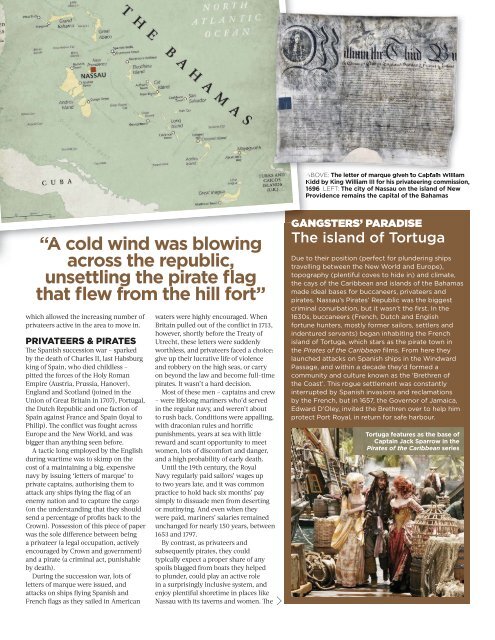You also want an ePaper? Increase the reach of your titles
YUMPU automatically turns print PDFs into web optimized ePapers that Google loves.
ABOVE: The letter of marque given to Captain William<br />
Kidd by King William III for his privateering commission,<br />
1696 LEFT: The city of Nassau on the island of New<br />
Providence remains the capital of the Bahamas<br />
“A cold wind was blowing<br />
across the republic,<br />
unsettling the pirate flag<br />
that flew from the hill fort”<br />
which allowed the increasing number of<br />
privateers active in the area to move in.<br />
PRIVATEERS & PIRATES<br />
The Spanish succession war – sparked<br />
by the death of Charles II, last Habsburg<br />
king of Spain, who died childless –<br />
pitted the forces of the Holy Roman<br />
Empire (Austria, Prussia, Hanover),<br />
England and Scotland (joined in the<br />
Union of Great Britain in 1707, Portugal,<br />
the Dutch Republic and one faction of<br />
Spain against France and Spain (loyal to<br />
Philip). The conflict was fought across<br />
Europe and the New World, and was<br />
bigger than anything seen before.<br />
A tactic long employed by the English<br />
during wartime was to skimp on the<br />
cost of a maintaining a big, expensive<br />
navy by issuing ‘letters of marque’ to<br />
private captains, authorising them to<br />
attack any ships flying the flag of an<br />
enemy nation and to capture the cargo<br />
(on the understanding that they should<br />
send a percentage of profits back to the<br />
Crown). Possession of this piece of paper<br />
was the sole difference between being<br />
a privateer (a legal occupation, actively<br />
encouraged by Crown and government)<br />
and a pirate (a criminal act, punishable<br />
by death).<br />
During the succession war, lots of<br />
letters of marque were issued, and<br />
attacks on ships flying Spanish and<br />
French flags as they sailed in American<br />
waters were highly encouraged. When<br />
Britain pulled out of the conflict in 1713,<br />
however, shortly before the Treaty of<br />
Utrecht, these letters were suddenly<br />
worthless, and privateers faced a choice:<br />
give up their lucrative life of violence<br />
and robbery on the high seas, or carry<br />
on beyond the law and become full-time<br />
pirates. It wasn’t a hard decision.<br />
Most of these men – captains and crew<br />
– were lifelong mariners who’d served<br />
in the regular navy, and weren’t about<br />
to rush back. Conditions were appalling,<br />
with draconian rules and horrific<br />
punishments, years at sea with little<br />
reward and scant opportunity to meet<br />
women, lots of discomfort and danger,<br />
and a high probability of early death.<br />
Until the 19th century, the Royal<br />
Navy regularly paid sailors’ wages up<br />
to two years late, and it was common<br />
practice to hold back six months’ pay<br />
simply to dissuade men from deserting<br />
or mutinying. And even when they<br />
were paid, mariners’ salaries remained<br />
unchanged for nearly 150 years, between<br />
1653 and 1797.<br />
By contrast, as privateers and<br />
subsequently pirates, they could<br />
typically expect a proper share of any<br />
spoils blagged from boats they helped<br />
to plunder, could play an active role<br />
in a surprisingly inclusive system, and<br />
enjoy plentiful shoretime in places like<br />
Nassau with its taverns and women. The<br />
GANGSTERS’ PARADISE<br />
The island of Tortuga<br />
Due to their position (perfect for plundering ships<br />
travelling between the New World and Europe),<br />
topography (plentiful coves to hide in) and climate,<br />
the cays of the Caribbean and islands of the Bahamas<br />
made ideal bases for buccaneers, privateers and<br />
pirates. Nassau’s Pirates’ Republic was the biggest<br />
criminal conurbation, but it wasn’t the first. In the<br />
1630s, buccaneers (French, Dutch and English<br />
fortune hunters, mostly former sailors, settlers and<br />
indentured servants) began inhabiting the French<br />
island of Tortuga, which stars as the pirate town in<br />
the Pirates of the Caribbean films. From here they<br />
launched attacks on Spanish ships in the Windward<br />
Passage, and within a decade they’d formed a<br />
community and culture known as the ‘Brethren of<br />
the Coast’. This rogue settlement was constantly<br />
interrupted by Spanish invasions and reclamations<br />
by the French, but in 1657, the Governor of Jamaica,<br />
Edward D’Oley, invited the Brethren over to help him<br />
protect Port Royal, in return for safe harbour.<br />
Tortuga features as the base of<br />
Captain Jack Sparrow in the<br />
Pirates of the Caribbean series

















